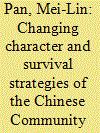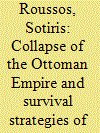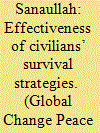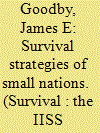| Srl | Item |
| 1 |
ID:
133739


|
|
|
|
|
| Publication |
2014.
|
| Summary/Abstract |
The Chinese community has been settled in India for more than two centuries. Its relationship to the host society and to the authorities, first British and then Indian, has gone through different stages with different forms. It is important to examine the lives, traditions and attitudes of the Chinese community to understand its development and its changing character. This study argues that it is misleading to present this community as one that has always been marginalised and discriminated against in India. It examines the applicability of concepts such as 'sojourning', 'corridors' and 'middleman minority' to the community and its different sub-groups, both in British India and in post-independence India.
|
|
|
|
|
|
|
|
|
|
|
|
|
|
|
|
| 2 |
ID:
179893


|
|
|
|
|
| Summary/Abstract |
The millet system compartmentalised religious communities into different sociopolitical environments under the overarching Ottoman imperial realm. However, during the nineteenth century, state transformation and crisis and the global re-allocation of political and economic power led to the exacerbation of ethnoreligious conflicts. Facing the collapse of the Ottoman imperium and the threat of extinction, the Greek Orthodox, Assyrian, Chaldean and Syrian Orthodox communities developed five survival strategies. The first was co-optation by state authorities; the second, protection of the Great Powers; the third armed resistance and the creation of autonomous enclaves; the fourth was that of exodus; and the last was to integrate themselves into Arab nationalism, lowering the banner of religion and becoming strong advocates of an Arab national identity encompassing Muslims and Christians alike. This paper aims to present a comparative approach to these strategies in the period from the beginning of the twentieth century to the formation of the Mandates
|
|
|
|
|
|
|
|
|
|
|
|
|
|
|
|
| 3 |
ID:
174605


|
|
|
|
|
| Summary/Abstract |
Civilians deploy various strategies to survive violence in armed conflicts; literature, however, does not debate the relative effectiveness of such strategies. This article answers how certain strategies are valued and are employed frequently in comparison to others. Based on qualitative fieldwork in Swat Valley undertaken in 2016 to 2019, where Taliban insurgents fought against the State of Pakistan in 2007–09, the research finds that civilians deployed resistance, accommodation, resolution, readjustment and withdrawal to survive. It further finds that as violence intensifies, strategies of resistance and accommodation give way to strategies of readjustment and withdrawal.
|
|
|
|
|
|
|
|
|
|
|
|
|
|
|
|
| 4 |
ID:
109856


|
|
|
|
|
| Publication |
2012.
|
| Summary/Abstract |
This article explores the development of kidnapping in Mexico City. New evidence suggests that this crime has evolved from a crime that until recently targeted mostly the wealthy to one that now targets mainly middle- and working-class individuals. This is counterintuitive since, arguably, kidnapping is a costly crime to plan and execute and is thus better suited for a once-off large payoff. Typical explanations of high crime rates and other criminal phenomena in Latin America argue that either a weak state or very powerful criminals explain high levels of crime and violence. I argue for a middle-ground approach that looks at the interactions between state, criminals and society to explain the changes mentioned. Using qualitative evidence, I explain this shift in kidnapping along three lines: (1) the successful destruction by the state of older, sophisticated kidnapping gangs; (2) the formal and informal strategies that wealthy individuals designed and implemented to protect themselves from crime; and (3) the failure of the state to impose a strong rule of law. The article concludes by reflecting on the importance of deep structural reform as a way to assure long-lasting drops in crime.
|
|
|
|
|
|
|
|
|
|
|
|
|
|
|
|
| 5 |
ID:
138597


|
|
|
|
|
| Summary/Abstract |
Not all small nations take quite such an extreme a view of their place in the world, but most of them have had historical experiences that justify this kind of existential fear. After all, the vulnerabilities of small nations have been demonstrated countless times throughout history. Thucydides famously recorded the fate of the island of Melos in his history of the Peloponnesian War between Athens and Sparta in the fifth century BCE. A passage in this history, usually called the ‘Melian Dialogue’, describes how the leaders of Athens decided that Melos, which was aligned with Sparta, should be absorbed into their empire. Accordingly, they demanded that
Melos capitulate, under threat of all-out war.
|
|
|
|
|
|
|
|
|
|
|
|
|
|
|
|